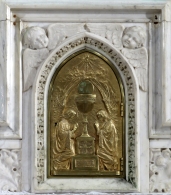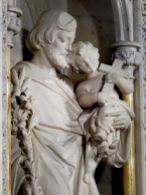In the depths of history a century is but a minute particle of time, and yet its passing allows a sufficient amount of dust to accumulate as to obscure the happenings of one hundred years ago…If through the reading of this reexamination of the past we can more fully appreciate the dimensions of the Faith of the pioneers of our parish; if we are, through their story, strengthened in our own Faith—made more proud of our heritage, and firmer in our determination that both shall be continued—then the effort expended in its presentation shall have been repaid the proverbial one thousand times.
Excerpt taken from St. Augustine’s Church Lansingburgh, New York, One Hundredth Anniversary 1864-1964.
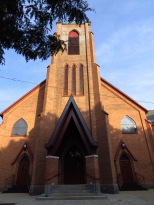 On the one hundredth anniversary year of St. Augustine’s Church, a history book was published recounting the efforts of reaching a centennial milestone. We can now add another fifty plus years to the words excerpted above, but the truth of history continues to ring true, dust may accumulate, but if “…through the reading of this reexamination of the past we can more fully appreciate the dimensions of Faith of the pioneers of our parish…” then we have brought life into our heritage.
On the one hundredth anniversary year of St. Augustine’s Church, a history book was published recounting the efforts of reaching a centennial milestone. We can now add another fifty plus years to the words excerpted above, but the truth of history continues to ring true, dust may accumulate, but if “…through the reading of this reexamination of the past we can more fully appreciate the dimensions of Faith of the pioneers of our parish…” then we have brought life into our heritage.
A Man Named Keating
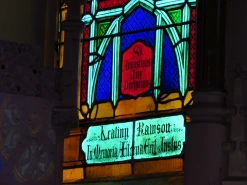
And pioneers they certainly were for “St. Augustine’s Parish in Lansingburgh exists because of the faith of one Irish woman and her love for her husband”….Annie Eustace, a woman of strong Irish Catholic background fell in love with Keating Rawson, an Anglican with Catholic ancestors. The two were wed in 1785, despite the opposition of their families, and they had subsequently had two children Sara in 1790 and Robert in 1792. A few years later, Keating and Annie Rawson, along with their son Robert, moved to the United States and settled in Lansingburgh, NY in 1795. Keating built his business in leather for the next 25 years and during this time was a vestryman of Trinity Episcopal Church, Lansingburgh (this church still exists directly across from St. Augustine’s today). When his son Robert died in 1814 it was his wife, Annie’s steadfast love, that caused an awakening in Keating to return to the faith of his ancestors. His conversion into the Catholic Church was completed by 1820.
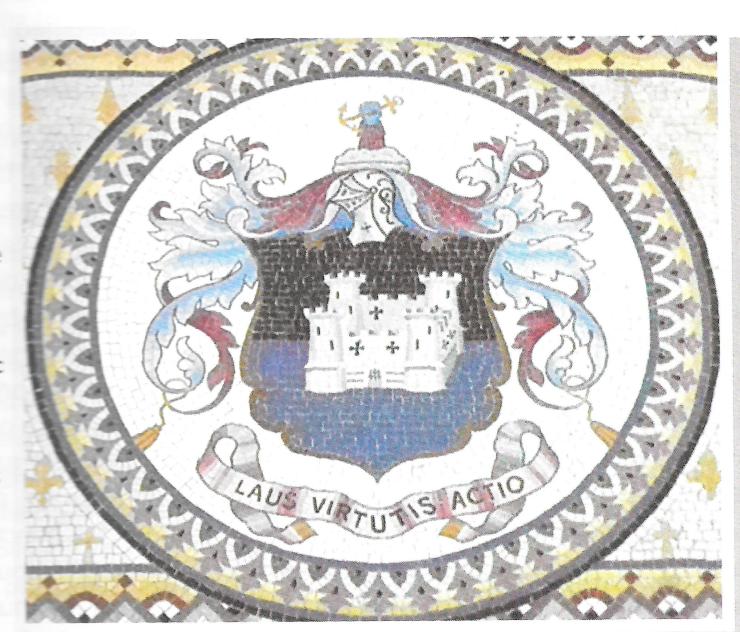
It was in this same year that Keating and Annie’s daughter, Sara, married John Tracey. Lansingburgh was in its early stages of development as a town. Men like Keating Rawson were trying to grow the community. Keating even joined with his new son-in-law and started a malt brewing company called “Rawson and Tracy”. It was in this same malt house that Keating and John dedicated a large room “No 1” for use in celebrating the Mass. The nearest Catholic Church, at that time, was in Albany. Priests would have to make visits to Lansingburgh to attend to the Catholics in Lansingburgh and the nearby Waterford area. Soon the need for a Catholic church became evident and Keating Rawson was a trustee of this project. St. Peter’s in Troy (now closed) was erected and the prospect of a Church for the Catholics of Lansingburgh was coming to fruition.
Even though tragedy again struck Keating with the loss of his “dear” Annie in 1829 and his daughter Sara in 1839, he never lost his drive to help provide a place of worship and on Sunday, June 5, 1842, “The Catholic Church of the Village of Lansingburgh” was incorporated in a wooden church bought by Keating for $1000. Through various efforts of the congregation, the debt was paid back to Keating and the church was dedicated as St. John the Baptist. A few months later, on November 18, 1842, Keating Rawson died and was buried next to his wife. A few days later his Son-in-law passed and was buried along with the Rawson family. The family later was moved to a Mausoleum in the local Oakwood Cemetery.
Growth and a Move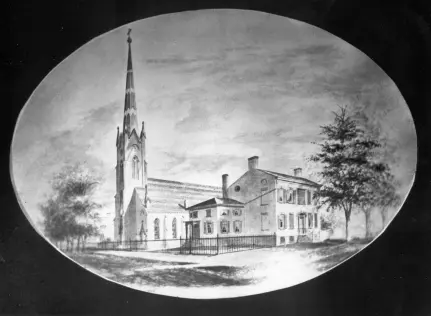
Our story does not end here, for this was only a chapter in our heritage epic. In 1858, the first Bishop of Albany, Bishop John McCloskey invited a number of religious orders to help the diocese to grow. The Augustinians who were chosen to pastor St. John the Baptist church. The second pastor, Most Rev. Thomas Galberry, OSA, arrived in 1860 and set to work for the church. Since the church building was being outgrown and in need of repair and t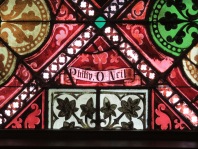 he original cemetery, which Keating Rawson purchased when his Annie had died, was also bursting at the seams, Fr Galberry set about obtaining the plot of land down the street where St. Augustine’s Church now stands. St. John’s Cemetary on the Hill was also purchased from Philip O’Neil, Jr. for the use of internments.
he original cemetery, which Keating Rawson purchased when his Annie had died, was also bursting at the seams, Fr Galberry set about obtaining the plot of land down the street where St. Augustine’s Church now stands. St. John’s Cemetary on the Hill was also purchased from Philip O’Neil, Jr. for the use of internments.
St. Augustine’s Church was erected near the corner of 115th Street and Fourth Avenue and the first Mass was held at Midnight December 25, 1864. The old church of St. John the Baptist was renamed Rawson Hall and held many activities for the church as well as the school. In 1867 Fr. Galberry was named the Commissary General of the Augustinian Order. Soon the Sisters of St. Joseph of Carondelet were invited to have a presence in Lansingburgh, and they arrived in 1869.
 Growth is the only word that can describe the next thirty years. Our heritage church grew in beauty as many stained glass windows were installed and a steeple with a bell was added. Societies to help clothe the poor were established along with other Sodalities to enhance the faith that was surely growing. Many of the pastors during this time had short stays but when Rev. John T. Emmett, OSA came in 1894 on the heels of some really wonderful Augustinians many changes occurred rapidly. The growing church needed some renovating and it started with replacing the two sacristies crowding the altar. A chapel was built on the side of the church to match the architecture and a new sacristy was put in between the church and chapel. New murals were added specifically those of the twelve apostles near the ceiling of the main body of our church and many parishioners were asked to model for the faces of the apostles. New pews were replaced as well as a new Baptismal font donated.
Growth is the only word that can describe the next thirty years. Our heritage church grew in beauty as many stained glass windows were installed and a steeple with a bell was added. Societies to help clothe the poor were established along with other Sodalities to enhance the faith that was surely growing. Many of the pastors during this time had short stays but when Rev. John T. Emmett, OSA came in 1894 on the heels of some really wonderful Augustinians many changes occurred rapidly. The growing church needed some renovating and it started with replacing the two sacristies crowding the altar. A chapel was built on the side of the church to match the architecture and a new sacristy was put in between the church and chapel. New murals were added specifically those of the twelve apostles near the ceiling of the main body of our church and many parishioners were asked to model for the faces of the apostles. New pews were replaced as well as a new Baptismal font donated.
Many Changes
The small school located at the previous church’s site was being outgrown rapidly and Fr. Emmett went to work getting an official school building built as well as an adjoining convent. 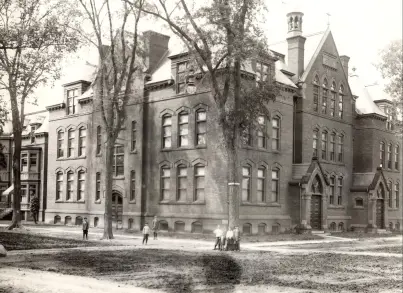 The cornerstone was laid in November of 1899 and St Augustine’s Academy was chartered by the Board of Regents on July 1, 1901.
The cornerstone was laid in November of 1899 and St Augustine’s Academy was chartered by the Board of Regents on July 1, 1901.
After Fr. Emmett passed away in 1910, the parish received another priest who took up the reigns of growth and beautification, Rev. James McCarthy, OSA. Fr. McCarthy was a kind man who continued to redecorate the interior of the church by adding the marble altars that we enjoy in the splendor of our church today. The Altars were imported from Italy and the columns are Sienna Marble. The original Angels on each side were too immense in weight and had to be relocated to the cemetery of St. John’s on the Hill. The side altars were dedicated to Our Lady of Good Counsel and St. Joseph.
The next two pastors were particularly important Rev. William Egan, OSA, and Rev. George Walker, OSA respectfully expanded the faith our parish further. Fr. Egan was the only pastor for three years, but in that short time he organized the Mother’s Club and expanded the work of the Sacred Heart Sodality, Holy Name and St. Vincent de Paul Societies. A softball league was organized as well as an addition started in the south wing of the church  building in 1934. Unfortunately, the passing of Fr. Egan, to a brain tumor, was all too soon, but Fr. Walker took up the work quickly and continued the addition on the church. In 1934, the Great Depression was making efforts to raise money for the necessary expansion very difficult. With other problems surfacing into the building project, including the discovery of the original church building had no foundation and the walls sat directly on the ground and that the underground springs for which Lansingburgh is known, were causing water seepage problems. Somehow with all of these setbacks, the work on the south aisle expansion was completed in 1935. It is now the location of the St. Nicholas of Tolentine shrine along with statues of St. Rita and St. Anne. As part of the renovation, the chapel was converted into a sacristy with all new vesting cases.
building in 1934. Unfortunately, the passing of Fr. Egan, to a brain tumor, was all too soon, but Fr. Walker took up the work quickly and continued the addition on the church. In 1934, the Great Depression was making efforts to raise money for the necessary expansion very difficult. With other problems surfacing into the building project, including the discovery of the original church building had no foundation and the walls sat directly on the ground and that the underground springs for which Lansingburgh is known, were causing water seepage problems. Somehow with all of these setbacks, the work on the south aisle expansion was completed in 1935. It is now the location of the St. Nicholas of Tolentine shrine along with statues of St. Rita and St. Anne. As part of the renovation, the chapel was converted into a sacristy with all new vesting cases.
Vatican II and Forward
Just Prior to Vatican II, St. Augustine’s church was the center of social and spiritual life in the Lansingburgh community (long since merged into the City of Troy in 1901, by the then Governor of New York, Theodore Roosevelt), but near the middle part of the last century it also was displaying the age of the church now very close to 100 years old. Demolition of the old parish hall (Bradley Hall) was underway and a new hall had to be built. By 1952 the construction was finished and the hall served the parishes needs for social events for many years after.  On August 10, 1956, the very tall and familiar steeple was removed because of irreparable timbers. About 5,000 people watched as the cranes lowered the 8-ton steeple to the ground. That same year under the guidance of the Rev. Eugene Mauch, OSA the Shrine of Our Lady of Lourdes was placed between the church and the rectory and it still stands today the whole shrine including the nearby Bernadette weighs 27 tons. Another necessary fix to the aging church came in the early 1960’s when Fr. Charles Hart, dealt with the sinking sanctuary from the weight of the marble altar. Everything was removed to pour a new cement subfloor and every
On August 10, 1956, the very tall and familiar steeple was removed because of irreparable timbers. About 5,000 people watched as the cranes lowered the 8-ton steeple to the ground. That same year under the guidance of the Rev. Eugene Mauch, OSA the Shrine of Our Lady of Lourdes was placed between the church and the rectory and it still stands today the whole shrine including the nearby Bernadette weighs 27 tons. Another necessary fix to the aging church came in the early 1960’s when Fr. Charles Hart, dealt with the sinking sanctuary from the weight of the marble altar. Everything was removed to pour a new cement subfloor and every 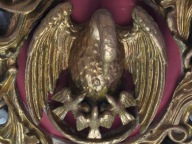 piece put back. So much more was accomplished that this author is not listing, but another notable renovation came in the form of faith building through beauty. Many parishioners believed the church at this time to be barren and cold feeling, so the D’Ambrosio Ecclesiastical Art Studios set to adding gold leaf to all of the ribs, rosettes, and beams, cleaned and restored all of the murals. The hope was to create an environment that was conducive to prayer and meditation. These efforts were accomplished and countered with the establishment of the Nocturnal Adoration Society which met on the first Friday of every month to adore the Eucharist.
piece put back. So much more was accomplished that this author is not listing, but another notable renovation came in the form of faith building through beauty. Many parishioners believed the church at this time to be barren and cold feeling, so the D’Ambrosio Ecclesiastical Art Studios set to adding gold leaf to all of the ribs, rosettes, and beams, cleaned and restored all of the murals. The hope was to create an environment that was conducive to prayer and meditation. These efforts were accomplished and countered with the establishment of the Nocturnal Adoration Society which met on the first Friday of every month to adore the Eucharist.
Over the next 40 years, Vatican II brought many good things to the parish along with some short-lived practices. Church tradition reigned as many faddish experiments in the liturgy waned in comparison to the beauty of our heritage church. By 1988 the church was in need of some restoration and Mass was celebrated in the parish hall and set up in a circular design, a suggestion was made by the architect to refurbish the church in this way, but the congregation universally dislike the modern setup. The idea was declined by Rev. Terrance Hyland, OSA, the then Pastor.
A Tough Time for All
“Never give up” could be a sentiment shared during this time because the needs were so evident when you looked at the buildings, but it is in the strength and character of the Parish—the people of St. Augustine’s—that stands out. We do not stagnate we do not give up, we rededicate, we re-devote, we become stronger together. Our spiritual life grows when we are challenged and friendships become bonded. In 1983, a program from the Albany Diocese called “Renew” became a huge success when small groups would gather in parishioner’s homes to share their faith with each other.
When parish buildings are aging it is only fitting to respond to repair and remodeling and this is what was seen during the span between the 1990’s to the present day. The church now sat with two large parking lots to the North and South and owned the old properties of origin a block South which housed the school, old convent, and hall. Even though the school had a large refurbishing in 1977, many things still needed to be done to maintain heat and use in the school. The Hall, which had been plagued with flooding and now age was once a central gathering place for many events through the years now showed a decrease in activities year by year. It soon became used solely for the school Gym, school cafeteria, and CYO basketball. Both buildings had a growing list of needs that had to be tended to amidst the last Sister of St. Joseph of Carondelet being transferred to her new home in the nearby Latham. Seventh and Eighth grades were discontinued under Bishop Hubbard and sent to nearby Catholic Central High School. Even though St. Augustine’s School became a “cluster school”—a school shared by many parishes—its numbers declined rapidly from in its early days of 1,200 enrolled students to less than 200.
The Church had some schedule changes of certain devotions and Adult Faith Formation was established along with Children’s Liturgy of the Word, but it was during this time that, in 1999, Rev. James Spenard, OSA came and he was set to work. After a centennial re-dedication of the school opportunities surfaced. With great efforts to bring the school into the millennium, Mr. Jim Clement was hired as principal and the efforts seemed to bring in a hope that the school could endure even with its declining numbers.
Albany Demographics also changed rapidly in as little as 100 years. Many immigrants, who began in Catholic Churches that spoke their language or kept their culture, were transformed by the American culture surrounding them. Many Churches sprung up in Troy during this time, but in the early 2000’s the Albany Diocese went through a painful process of “Called to Be Church”. Many old churches were closed surrounding St. Augustine’s. Fr. Spenard knew of the devotions of these closed churches for he was raised locally in the “sister church” across the bridge, St. Mary’s of the Assumption, in Waterford, NY; and he did not want these beautiful representations of our Catholic Troy roots to die. As the parishes began to close many of the traditions and devotions traveled to their new home of St. Augustine’s Church.

When St. Mary’s and St. Jeanne’s Churches closed their Devotion to St. Anne de Beaupre was received by our own parish and continues each July. When St. Patrick’s closed in 2010, Fr. Spenard brought the St. Patrick’s traditional Irish Mass to the Parish as a yearly celebration. Soon after, to preserve the history and beauty of historic pieces, St. Augustine’s Church obtained the Baptismal Font from St. Patrick’s Church.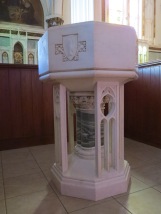 When our Chapel was being renovated, five windows from St. Paul’s were reinstalled for beautification and Historical maintenance.
When our Chapel was being renovated, five windows from St. Paul’s were reinstalled for beautification and Historical maintenance.
The most important and defining tradition that St.
Augustine’s has received from a local parish is that of Perpetual Adoration. St. Paul the Apostle Church in Troy, started  this 24-hour adoration on September 8, 1983, and in May of 2009, Fr. James Spenard, OSA, escorted the Blessed Sacrament from St. Paul’s to our own chapel. A limousine was provided for the protection and procession by the Sanvidge family. The Monstrance was elevated to be seen by all from the streets and was led and followed by the Troy Police department with another 35-40 cars following the procession. At all intersections, traffic was stopped for respect and reverence as the Blessed Sacrament arrived at its new home. A few years later the Our Lady of Perpetual Help Chapel was renovated and beautified for the devotion of 24-hour adoration.
this 24-hour adoration on September 8, 1983, and in May of 2009, Fr. James Spenard, OSA, escorted the Blessed Sacrament from St. Paul’s to our own chapel. A limousine was provided for the protection and procession by the Sanvidge family. The Monstrance was elevated to be seen by all from the streets and was led and followed by the Troy Police department with another 35-40 cars following the procession. At all intersections, traffic was stopped for respect and reverence as the Blessed Sacrament arrived at its new home. A few years later the Our Lady of Perpetual Help Chapel was renovated and beautified for the devotion of 24-hour adoration.
Devotions continued to grow and the St. Vincent de Paul Society was now serving over 100 families and the Respite ministry was established to support the caregivers of those with various forms of dementia. The Church also underwent some modernization in the form of better outdoor lighting, energy efficiency on indoor lighting, a new sound system (well hidden so the beauty of the Church could be maintained), air conditioning and renovations to bring back beauty to some non-aesthetically pleasing elements to the building, as well as safety features added.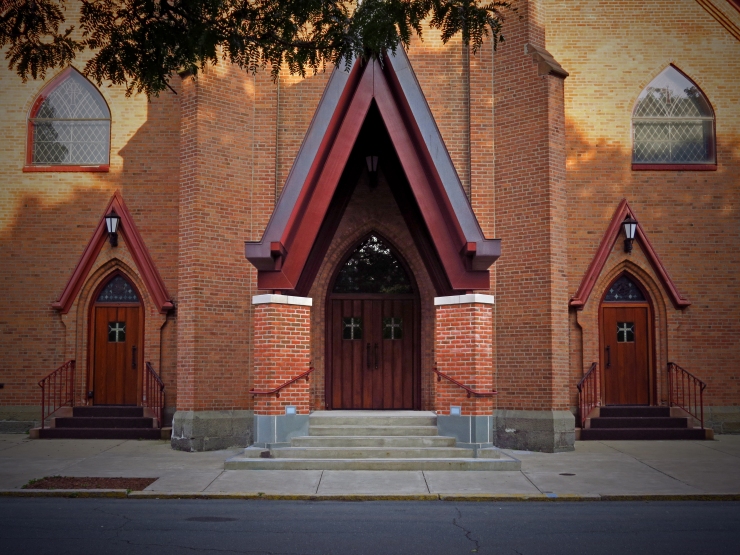
In 2012, Bishop Hubbard assigned a parishioner and Deacon Tom Colton as a permanent Deacon of our Parish to assist the priests with the many duties of the Church. As a church we celebrated Fr. Jim Spenard’s 40th Anniversary of his Ordination and subsequently the 150th and 170th Anniversaries of our Church and Parish.
After 18 years of serving St. Augustine’s Parish, our beloved Fr. Jim was relocated to St. Rita’s Shrine in Philadelphia. We continue to grow spiritually under the guidance of our current Pastor, Fr. David Kelley, OSA.
Because numbers continued to decline at the school into the new millennium, the cost of running a school and maintaining an old building as well as obvious shifts in demographics in the community, the decline of choosing private education along with a myriad of other factors, it was  evident that the school could not be maintained. After 147 years, on June 23, 2016, St. Augustine’s School closed its doors for good. Valiant efforts were not only evident among the teachers, staff, students, and parents during its final years but also through the support of our own parishioners, other parishes, and the community. This was not an easy thing to endure, nor was it an easy decision to be made as many parishioners shared their own memories within the walls of that school and had ancestral heritage there; including this author’s own children being among the 98 students that finished out the final year there.
evident that the school could not be maintained. After 147 years, on June 23, 2016, St. Augustine’s School closed its doors for good. Valiant efforts were not only evident among the teachers, staff, students, and parents during its final years but also through the support of our own parishioners, other parishes, and the community. This was not an easy thing to endure, nor was it an easy decision to be made as many parishioners shared their own memories within the walls of that school and had ancestral heritage there; including this author’s own children being among the 98 students that finished out the final year there.
“What does love look like? It has the hands to help others. It has the feet to hasten to the poor and needy. It has eyes to see misery and want. It has the ears to hear the sighs and sorrows of men. That is what love looks like.”
Saint Augustine
Currently, we are moving forward “with the times”. We are updating carpets and maintaining and growing our many devotions. This website was developed to connect our community with the growing tech that so many parishioners use daily. Something is going on and it is through the efforts of this devoted Parish Community and the guidance of reverent priests that we move forward with faith, hope and charity into the future.
What is to be seen? What is to be learned? What is to be loved?
In the words of Fr. James Spenard, OSA, “…we have looked…into each generation…we’ve traced individuals and families…bricks and mortar. We have seen life and death….comings and goings…things that make us laugh….and things that make us cry; through it all, we have seen the face of God in the Mass and the Sacraments….When we learn that the future is a promise that helps us always to look up to the heavens, not down to earth…the past is a…[teacher] that we are always drawing from…and the present is a gift…from the Creator…for use here and now. To do with what we can in faith, in hope, and in charity with our gift. [So,] what’s to be loved? Look around. [You’ll find] the spirit of hospitality and generosity, [and] the tremendous sense of ‘oneness’ with humanity that seems to put each parish response to the catastrophe in some far-off place…over the top in sacrifice. We see it in the generations already lived….we see it in the continuity of family members who are proud of their Catholic roots in this place. We see it in programs for our youth and in care for those whose needs have changed. It’s indeed a privilege to be…in a place like St. Augustine’s…we are indeed all in this together.”



















